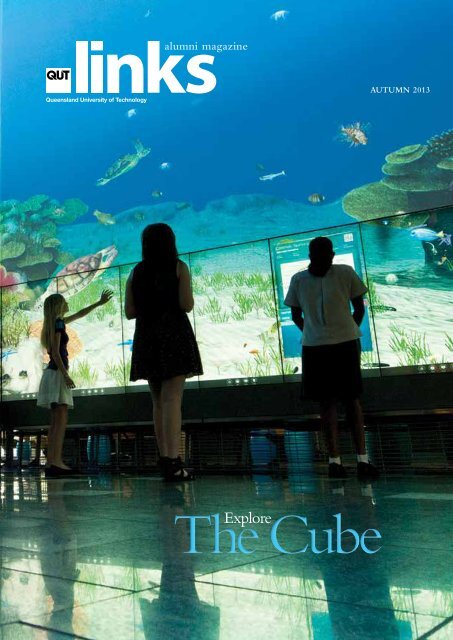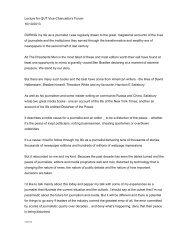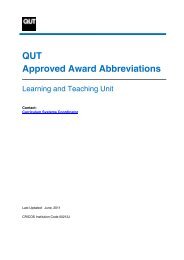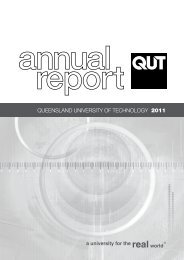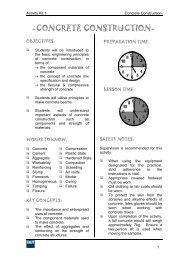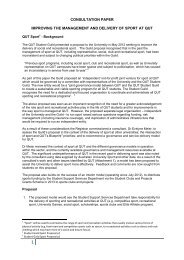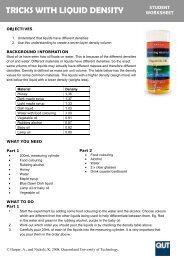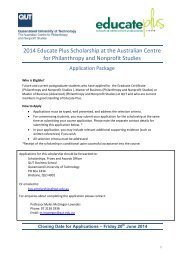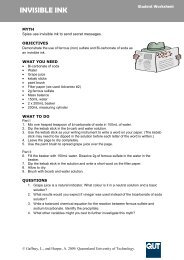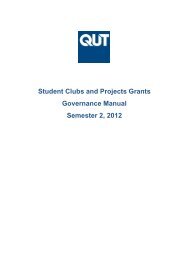QUT Links magazine Autumn 2013
QUT Links magazine Autumn 2013
QUT Links magazine Autumn 2013
Create successful ePaper yourself
Turn your PDF publications into a flip-book with our unique Google optimized e-Paper software.
alumni <strong>magazine</strong>AUTUMN <strong>2013</strong>TheExploreCube
contentsVOLUME 16 NUMBER 14Profiles11419Seeking justice for warcrimes – our latest RhodesScholar, Andrew Trotter.At 26, Felicity Briody isamong the most influentialwomen in the nation.Meet theBurger Brothers.Features4-92021Brisbane’s new landmark:the <strong>QUT</strong> Science andEngineering Centre.Hummingbird Househelps sick children.Introducingthe new <strong>QUT</strong>Alumni Board.1410Research31011121617Award-winning work torestore damaged vision.The challenges ofChlamydia and infertility.How skateboards canmake maths fun.Taking the PhD pathless travelled.Carbon trading:a hotbed of fraud.Should soldiers defyillegal orders?RegularsNEWS ROUNDUP 2Research Update 18Alumni nEWS 22-23KEEP IN TOUCH 24Last WORDby Vice-ChancellorProfessor Peter Coaldrake- See inside back coveralumni <strong>magazine</strong>linksEditorStephanie Harrington/Rose Trapnellp: 07 3138 2361e: media@qut.edu.auContributorsJanne RaynerKen GideonSandra HutchinsonMechelle McMahonAlita PashleyNiki Widdowson13In focusBenjamin Lawhas establishedhimself among thenext generation ofAustralian storytellers.ImagesSonja de SterkePatrick HamiltonDesign Richard de Waal<strong>QUT</strong> <strong>Links</strong> is published by <strong>QUT</strong>’sMarketing and CommunicationDepartment in cooperation with <strong>QUT</strong>’sAlumni and Development Office.Editorial material is gathered froma range of sources and does notnecessarily reflect the opinions andpolicies of <strong>QUT</strong>.CRICOS No. 00213J
<strong>QUT</strong>LINKS AUTUMN ’131Crime &punishment<strong>QUT</strong>’s newest Rhodes Scholaris determined to seek justicefor international war crimes.SEEING alleged international criminals judged fairly andexpeditiously in their own countries is the goal of QueenslandRhodes Scholar, <strong>QUT</strong> law graduate Andrew Trotter.When Mr Trotter (pictured), also one of the university’sinaugural Vice-Chancellor’s scholars, graduated last yearwith distinction in a Bachelor of Arts and with first-classhonours in a Bachelor of Laws degree, he already had someinternational war crime trial experience under his belt.He completed internships at the International CriminalTribunal for the former Yugoslavia in The Hague where heworked for judges in the trial of Bosnian Serb ex-army chiefRatko Mladic, at the Office of the Co-Prosecutors in theExtraordinary Chambers in the Courts of Cambodia (theKhmer Rouge trials), and at the South Asia Human RightsDocumentation Centre in India.Mr Trotter’s interest in international criminal law wassparked when he took part in an International CriminalCourt moot in The Hague while on a <strong>QUT</strong> exchangeprogram in Taiwan. He walked away with the award for BestTrial Lawyer.At Oxford University, <strong>QUT</strong>’s sixth Rhodes Scholar willstudy theories of criminal law, in particular as they relate toprosecutions for international crimes.“It is an exciting and important area of the law,”Mr Trotter said.“Those countries that have been affected by crimesperpetrated during conflict need an appropriate level ofinternational support to run trials so they can administerjustice according to law in their own countries.“In Cambodia, the public flooded into the courts. Theywanted to be witness to the legal process. Justice must notonly be done, but seen to be done.“The people working on the Khmer Rouge trial and at thetribunal in Yugoslavia were of great integrity and commitmentand I learnt much from their expertise.”Mr Trotter will take up his three-year scholarship at Oxfordnext year after completing an associateship with High Courtof Australia Chief Justice Robert French.“I’m really looking forward to the intellectual challenge,”Mr Trotter said.“To have my ideas and assumptions constantly questionedand interact with other Rhodes Scholars from around theworld is an exciting prospect.”– Rose Trapnell
2 <strong>QUT</strong>LINKS AUTUMN ’13news roundup…News of new appointments, university successes, achievements of staff and students, and corporate events.Business and Healthdeans appointedNew deans have been appointedto <strong>QUT</strong> Business School and theFaculty of Health.Professor Robina Xavier (pictured)is the new Executive Dean ofBusiness at <strong>QUT</strong>, while ProfessorRoss Young (pictured) has beenappointed as the new ExecutiveDean of Health.Professor Xavier previouslyheaded the School of Advertising,Marketing and Public Relations forsix years, and has more than 20 years’experience in the tertiary sector.She is also a past president of thePublic Relations Institute of Australia(PRIA). Her teaching and researchfocuses on crisis communication andshareholder communication.Professor Young’s previous <strong>QUT</strong>posts include serving as executivedirector of the Institute of Healthand Biomedical Innovation (IHBI)from 2006 to 2012, and head of<strong>QUT</strong>’s School of Psychology andCounselling. Professor Young, aclinical psychologist, researches areasincluding substance misuse andmajor psychiatric illness.ERA researchranking world classResearch at <strong>QUT</strong> has receivedworld-standard ranking in the FederalGovernment’s 2012 Excellence inResearch for Australia (ERA) nationalassessment. The ERA ranked 95per cent of <strong>QUT</strong>’s broad disciplineresearch areas at world standard andabove. Materials Engineering had thebiggest jump universitywide, after beingbumped up two spots to a five (thehighest rating). Communication andMedia Studies also maintained its toprating of five.Walkley winnerstake a bowFour <strong>QUT</strong> journalism alumni havewon prestigious Walkley Awards.The awards recognised 7.30 hostLeigh Sales for tough questions put toOpposition Leader Tony Abbott andother interviewees, and investigativejournalist Amanda Gearing for a flooddocumentary that aired on ABC RadioNational. Walkleys also went to AngusGrigg for best newspaper feature(‘The Punters Club – tax, totes andthe boys from Tassie’, The AustralianFinancial Review) and the ABC’s NanceHaxton for a report about victims ofsexual abuse.Research centres bringbig matters into focusTWO new research centres have opened their doors in the Facultyof Law. The Health Law Research Centre is tackling such life anddeath matters as palliative care, advance directives, withholdingand withdrawing life-sustaining treatment, and surrogacy, abortionand artificial reproductive technology. The new centre is hometo Australia’s largest group of health law academics includingco-directors Professors Ben White and Lindy Willmott (pictured).Professor Belinda Carpenter, meanwhile, will lead <strong>QUT</strong>’s Crimeand Justice Research Centre. It will conduct independent researchinto controversial areas including carbon trading fraud, LGBTI(lesbian, gay, bisexual, transgender and intersex) youth andpolicing, romance scams, violence in mining communities and sextrafficking legislation. The School of Justice has also launched anew International Journal for Crime and Research.
<strong>QUT</strong>LINKS AUTUMN ’133RESTORING vision to eyes whose surface hasbeen damaged by trauma or disease is on thehorizon thanks to world-leading research by aBrisbane-based biomedical scientist.Dr Laura Bray (pictured), from the Instituteof Health and Biomedical Innovation (IHBI)at <strong>QUT</strong> and the Queensland Eye Institute, isthe recipient of the inaugural Prime Minister’sQueen Elizabeth II Diamond Jubilee Award.She will use the $118,000 award, whichsupports the advancement of women’s leadershipin Australia, to further her research at the LeibnizInstitute for Polymer Research in Dresden,Germany, for two years.Dr Bray, who is passionate about womenmoving into biomedical engineering leadershiproles, decided to research ways to improveoutcomes for patients with eye injuries whenher brother’s eye was damaged by a nail on abuilding site.“I am researching the use of fibroin, a proteinfound in silk fibres, to repair injuries to thesurface of the eye,” Dr Bray said.“When eyes are damaged by foreign objects orworkplace accidents such as chemical burns, orby some congenital, immunological or bacterialdisease, the limbal stem cells needed to repair thecornea’s surface can become deficient.“I’m looking at ways to engineer the silkmaterials to create a more natural environmentin which to grow limbal stem cells that can betransplanted back to the eye to improve vision.”Dr Bray said a deficiency of these stem cellscaused conjunctival tissue, normally coveringthe white of the eye, to grow over the cornea’ssurface, leading to loss of sight and pain.“Fibroin with growth factors could helpregenerate the cornea and reduce scarring as thesilk degrades away.”Dr Bray said her laboratory at IHBI waspossibly the only one in the worldgrowing primary human limbalstem cells on silk fibroinmaterials.“This research could assistmy brother to regain some ofhis vision in the future, alongwith others like him whocannot benefit from currenttreatment methods.” – Niki WiddowsoninsightEngineeringSilk and stem cells could bethe key to repairing debilitating eye injuries.
4 <strong>QUT</strong>LINKS AUTUMN ’13
<strong>QUT</strong>LINKS AUTUMN ’135Science and EngineeringCentre<strong>QUT</strong>’s Science and Engineering opensBringing scienceto the big screensWorld-best technology –unveiled at <strong>QUT</strong> by the PrimeMinister of Australia, the Hon.Julia Gillard MP, and QueenslandPremier, the Hon. CampbellNewman MP – will revolutionisescience and engineering teachingand research.The official opening of theCentre on February 28, <strong>2013</strong>.
6 <strong>QUT</strong>LINKS AUTUMN ’13The Cube, at two storeys high and one ofthe world’s largest touch and display systems,is a centerpiece public feature of <strong>QUT</strong>’snew $230 million Science and EngineeringCentre at its CBD Gardens Point campus.The Cube is a unique technicalaccomplishment that took <strong>QUT</strong> developersmore than two years to build, and offersunprecedented learning and researchopportunities.It comprises 190 sqm of high-definitionscreens including 48 touch panels whichintegrate with 14 high-definition projectorsto reach a massive 115-megapixel resolution.Open to the public, The Cube will enthrallas it inspires future scientists.Thousands of high school students arealready booked in to explore the giganticdigital science lab and take part in nationalcurriculum-linked workshops.<strong>QUT</strong> is the only Australian university withan embedded LEGO Education LearningCentre (left), where high school studentstake part in hands-on sessions focusing
7on robotics.The Cube’s Physics Playroomprovides a game-like environment wherepeople of all ages can learn about the conceptsof physics.The capacity of The Cube will helpresearchers analyse and visualise complexsystems and other data, driving collaborationamong researchers and with the real world.<strong>QUT</strong> Vice-Chancellor Professor PeterCoaldrake said The Cube and the newScience and Engineering Centre would betransformational in many ways.‘Transparent’ analysis labsenable students and the public tosee research being undertaken.Sitting opposite Old GovernmentHouse, the new Centre hastransformed Gardens Point campus.
8 <strong>QUT</strong>LINKS AUTUMN ’13The Centrehouses a new50m pool.The scanningtunnellingmicroscope isone of a suite ofsuper microscopeslocated withinthe Centre’sCentral AnalyticalResearch Facility.“The technology developedby <strong>QUT</strong> will transform the waypeople think about science. Thespectacular public spaces and first-classcommunity facilities have transformedthe Gardens Point campus, and as acity landmark the Centre transformsthe gateway to Brisbane,” ProfessorCoaldrake said.The Science and EngineeringCentre is headquarters to <strong>QUT</strong>’snewest research institute, as well ashousing some of the nation’s mostadvanced electron microscopes in a$17 million analytical research facility.The new Institute for FutureEnvironments is working to solvesome of the world’s most pressingproblems – from tackling global foodsecurity to managing scarce naturalresources.It brings together more than 300scholars from the fields of science,technology, engineering, mathematics,business and law to seek solutionscollaboratively.“The entire Science andEngineering Centre is built aroundan ethos of collaboration,” ProfessorCoaldrake said.“The benchmark design of theCentre’s open, stimulating spaceswith flexible technology and invitinglounge areas was informed by a newunderstanding of how people learn.”Among the high-level researchlabs, workstations, glass-lined meetingrooms and hi-tech public areas arequaint, retro spaces designed to givepersonality and warmth to the Centre.From its subtropical surroundsto the rooftop, the Science andEngineering Centre is a sustainabilityshowpiece so green that it is evenpowered by trees – solar trees thatare programmed to follow the sun,thereby drawing maximum energyevery day.The Centre is a certified 5Star Green Star rated building in“Education v1” for “Design”.It is powered by a combinationof grid power, natural gas and solarenergy, generating enough electricityto power itself and to also put powerback into the <strong>QUT</strong> grid.This tri-generation system has beenengineered to reuse rather than loseheat, with heat being used to cool theair-conditioning systems, de-humidifylabs and heat the swimming pool.The Science and EngineeringCentre was jointly funded by theCommonwealth Government ($75million), the Queensland Government($35 million), Atlantic Philanthropies($25 million) and <strong>QUT</strong> ($95 million).– Janne RaynerThe Centre is a 5 StarGreen Star rated buildingin ‘Education v1’for ‘Design’Botanic Bar
<strong>QUT</strong>LINKS AUTUMN ’139Collaborativeand quirky –the designof the Centre’slearning spacesreflects a newunderstandingof how studentslearn.
10 <strong>QUT</strong>LINKS AUTUMN ’13Switching off the body’simmune response couldrender a devastatinginfection harmless.ertileFertile groundsA SURPRISE discovery has won a <strong>QUT</strong> PhD graduate anational Research Excellence Award and may well be thefoundation of a needle-free Chlamydia vaccine.Connor O’Meara (pictured), a postdoctoral fellow fromthe Institute of Health and Biomedical Innovation (IHBI)at <strong>QUT</strong>, said working on controlling the body’s response toChlamydia was the key to preventing infertility.“The infertility that can develop because of a Chlamydiainfection occurs as an indirect result of the body’s immuneresponse trying to get rid of the infection and not from theChlamydia itself,” he said.“Therefore, if we can manipulate this harmful immuneresponse we can prevent infertility.”Dr O’Meara said that while trialling the use of adjuvants(agents commonly used in vaccines) he uncovered a wayof effectively “switching-off” the body’s harmful immuneresponse, which kills the Chlamydia bacteria but also causesmassive scarring to the reproductive system.“We have been able to suppress the body’s damagingimmune response and prevent infertility, but what is mostinteresting is that this protection developed independentlyof the control of the infection,” he said.The discovery earned Dr O’Meara Australia’s 2012AusBiotech-GSK Student Excellence Award at theAusBiotech national conference.“Common practice is to try and develop a vaccine toget rid of the infection, however this approach often fails toprevent infertility,” he said.“We’re trying to train the body not to react so aggressivelytowards an infection, essentially making Chlamydia harmless.”Dr O’Meara said they were also looking at a vaccine thatcould be delivered without needles.“Queensland currently has the highest levels of Chlamydiainfections per capita in Australia and national notification ratesare increasing by almost 20 per cent each year,” he said.“It is also estimated that untreated Chlamydia infectionscost the Australian health system $90 million to $160 millioneach year.“This work will help influence how we design futurevaccines against Chlamydia, but also against other pathogensthat cause disease as a result of the body’s immune response.”– Alita Pashley
<strong>QUT</strong>LINKS AUTUMN ’1311On a rollA deadly maths program is makinglearning as easy as child’s play.BY using a skateboard, dice and other items often associated withchildren at play, <strong>QUT</strong> researchers are revolutionising the waymaths is being taught in schools throughout Queensland and farbeyond.The YuMi Deadly Maths program, developed at the YuMiDeadly Centre (YDC) in <strong>QUT</strong>’s Faculty of Education,incorporates common objects into learning to show studentshow maths is used in everyday life.Lead researcher Dr Bron Ewing (pictured) said the QueenslandGovernment-funded program, which is being rolled out to morethan 1000 primary and secondary schools across the state, wasachieving solid results.“In many cases students’ maths learning has improved,” she said.“Students learn how to apply their maths understanding byusing objects they’re familiar with.“For example, they can learn about angles by considering a360° turn on a skateboard and about fractions by cutting fruitinto sections.“Teachers are finding their students are more attentive andmotivated to attend class.”YuMi Deadly has been so successful it has expanded intoVictoria, with expressions of interest from as far afield as Thailand.Originally designed for Indigenous and low socioeconomicstudents in Queensland state schools, YuMi Deadly has beenadapted to benefit migrant and refugee children and those at riskof disengaging.It is now being taught in 12 schools in Victoria and has alsosparked an Australian Thai Mathematics Education project, acollaboration between YDC and school directors and teachers inChiang Mai, Thailand.Elements of the program have also been incorporated into aconstruction course at Mt Isa TAFE.“This method of teaching provides students of all ageswith positive education experiences, and equips them forlifelong learning,” Dr Ewing said.With schools at Vincent in Townsville, Sunshine inMelbourne, and Marsden and Beenleigh south of Brisbanebecoming Centres for Excellence in YuMi Deadly Maths,further promotion and expansionof the program is likely.- Rose TrapnellBeenleigh State Schoolstudent Cardell Jones throwsdice as part of a YuMiDeadly maths activity.
12 <strong>QUT</strong>LINKS AUTUMN ’13Write choiceWHEN Bridie Scott-Parker donned a cap and gownand added the title of “Doctor” to her name, she had11 peer-reviewed papers under her belt, had travelled theworld speaking at road safety conferences and boasted aninternational research reputation.That is because unlike 82 per cent of her <strong>QUT</strong> graduatingpeers, the CARRS-Q researcher (pictured) had taken the PhDpath less travelled – a PhD by Publication.A PhD is not a one-size-fits-all prospect. At <strong>QUT</strong> there arethree options for students: the PhD traditional thesis, the PhDby Publication and the PhD by Creative Works.Dr Scott-Parker completed a Bachelor of Psychology andfrom there undertook an honours program looking at therisky behaviour of young drivers.After being awarded the RACQ Road Safety Prize for themost outstanding fourth-year thesis, Dr Scott-Parker decidedto embark on a PhD studying the factors contributing to theincreased crash risk of young drivers.“With my honours research I published a paper in apeer-reviewed journal, so I had had some experience inpublishing,” she said.“I had also had people around the world contact mebased on those publications asking if I would be interested incollaborating in their research projects.“This signalled to me that publishing my findings, ratherthan waiting for three or four years after I’d finished myresearch, would be a better option for me.”With a PhD by Publication, just like a traditional thesis,students are required to tell a story but that story must includepublished papers.“It certainly isn’t the easy option. Many people conducttheir research and then spend the last year or so writing. Witha PhD by Publication, you need to write from day one,”Dr Scott-Parker said.But a PhD by Publication has opened doors.“I am collaborating with researchers in Germany, who sawone of my publications in a former ERA A-star publication,”she said.“That would never have happened otherwise ... because mythesis is still not available in the public realm even though I dohave my doctorate conferred.”- Sandra HutchinsonTaking the PhD path lesstravelled has boosted thecareer of this graduate.
<strong>QUT</strong>LINKS AUTUMN ’1313LAWAUNTO HIMSELFThis Brisbane writer’s words willunfold on the small screen.WITH equal parts genuine talent, devilish wit and oldschoolcharm, Benjamin Law seems purpose-built tobe an ambassador for the next generation of Australianstorytellers.Since completing a Bachelor of Arts with honours anda PhD in Creative Industries at <strong>QUT</strong>, he has penned twobooks – The Family Law in 2010 and Gaysia: Adventures in theQueer East in 2012 – is a regular contributor to Frankie,The Monthly, Q Weekend and Good Weekend and has appearedon ABC’s Q&A. And this was all before his 30 th birthday.But Dr Law (pictured), a native of QLD’s SunshineCoast, humbly attributes his speedy rise through the ranksof the Australian literary scene to being “a disgustingopportunist”.“My first book came out because there was ananthology called Growing Up Asian in Australia. I thought,‘Wow. I grew up Asian in Australia and I’m a writer.This is made for me’,” he said.“I didn’t hear back for a long time and felt sort ofdeflated. It turned out they wanted to know if I couldwrite more with the possibility of turning it into a bookand I thought, ‘Yeah, maybe I could’.”Five years later, The Family Law has been hailed as astand-out debut, was nominated for three accolades inthe 2011 Australian Book Industry Awards and is beingdeveloped for TV by Matchbox pictures, the productioncompany behind The Slap and The Straits.“It’s in its embryonic phase at the moment. They(Matchbox) are gently holding my hand saying,‘Benjamin, this is how you do this very basic task’.They’re very good at teaching me exactly what I’msupposed to be doing,” he said.With Gaysia cementing Dr Law’s reputationas an author with plenty to say, he admitshe has no idea where the next five years maytake him.“I’m a terrible planner so as far as a masterplan for a career, I haven’t really sat down andthought of what I’d like to do,” he said. “Forme it’s been about doing slightly stupid things.Things I’ve realised after the fact are difficultor moronic. But by the end of it you mighthave something good to show for it.”– Alita Pashley
14 <strong>QUT</strong>LINKS AUTUMN ’13Powerplay
<strong>QUT</strong>LINKS AUTUMN ’1315It’s not just for men in hard hats. Felicity Briody is changingwomen’s views about engineering.AT just 26, Felicity Briody is listed among the top 100 mostinfluential women in the nation.Named alongside surfing great and philanthropist LayneBeachley, Business Council of Australia boss Jennifer Westacottand Origin Energy chief operating officer Karen Moses in theAustralian Financial Review’s top 100 Most Influential Womenin Australia, the <strong>QUT</strong> engineering alumnus (pictured left) issomewhat humbled by the accolade.“It’s awesome … I guess I am a bit blown away by it still,”she said.Ms Briody, who works with global professional technicalmanagement and support services firm AECOM in Brisbane,received the honour for her initiative in co-founding thePower of Engineering program, a not-for-profit organisationthat is changing the perceptions of how young women view acareer in engineering.Last year Ms Briody held 10 events for high schoolagedstudents, talking to them about the opportunitiesengineering offers.“It’s been said to me that a career in engineering is likebeing a super hero. You get to play with the forces of nature,”the civil engineering graduate said.“I tell people that with engineering you have the powerto change the world around you. If you want to make adifference, this is the path to do that.”As a young woman in a male-dominated industry,Ms Briody acknowledges she’s a small fish in a big pond.“But I think there are barriers and unconscious biases in allindustries,” she said.“When I first started my career after finishing uni, Ithought I had to be the same as everyone else. But now I haverealised that being different is a valuable asset.“I think women bring a lot to the table. From myperspective, I am a good communicator and also good atgetting teams to work together.”Ms Briody said many young women viewed engineering as“men in hard hats” and limited to buildings, cars and bridges.“As part of the Power of Engineering events, I have beengoing out there and telling students what engineering reallyis,” she said.“I am empowering them to think about engineering in adifferent way.”– Sandra HutchinsonTaking the lead in workplace safetyCOMPANY boards have a powerful role to play ininfluencing the safety outcomes of the organisations theygovern beyond pure compliance with relevant workplacesafety legislation, experienced company director and <strong>QUT</strong>PhD researcher Kirstin Ferguson (pictured above) said.Ms Ferguson, who is on the listed board of Dart EnergyLtd and is also the first female non-executive director ofthe Queensland Rugby Union Board, has undertaken anAustralian-first study investigating the role of boards indriving safety outcomes within organisations.Her Colin Brain Governance Fellowship, awarded through<strong>QUT</strong> Business School, recognises the research importance ofher study into corporate governance.Ms Ferguson said the responsibility and liability ofdirectors had been catapulted into the spotlight followingnew Workplace Health and Safety Acts and high-profilesafety disasters including the New Zealand Pike River mineexplosion and the 2011 BP oil spill in the Gulf of Mexico,where the role of the board had been addressed.“One of the outcomes of this research will be to createa governance framework for best practice in terms of safetygovernance,” she said.Ms Ferguson graduated with a <strong>QUT</strong> Bachelor of Lawsdegree with honours in 2001.
16 <strong>QUT</strong>LINKS AUTUMN ’13Carbon copyAustralia must learn from the European Union’smistakes if we are to get tough on polluters.Carbon copyWHEN Australian companies enter the European carbontrading scheme in 2015, they will join a complex and poorlyregulated market that is a hotbed of fraud.Assistant Dean of Research in the Faculty of Law ProfessorReece Walters (pictured) said the carbon trading market,which has operated in Europe since 2006, offered massiveopportunities for criminals and had done little to reducepollution, while governments lacked the will and internationalpolicing capacity to deal with the situation.He said European Union (EU) countries continued toexceed agreed-upon pollution targets, while companiesfalsified records to show they emitted less pollution.“Industry regulation is so lax that on the whole they areable to get away with it,” Professor Walters said.He said that while companies generally employed brokersto buy and sell their credits on the carbon market, themarket was peppered with dodgy brokers who set up boguscompanies to trade in credits.“Again because of lax regulation these companies get awaywith not paying Value Added Tax (VAT) to government. InBritain alone these violations are costing the public millions ofpounds per year.”Professor Walters said carbon credits were like a ‘get-outof-jail-freecard’ for big polluters, who often offset theirpollution by investing in ‘green’ projects that were foistedupon Indigenous communities and that often destroyed theirnative vegetation.He said reputable companies wanting to offset theircarbon emissions needed to be sure that the brokers theyused were reputable too, or they ran the risk of fundingunwanted projects.Professor Walters said much work needed to be done toensure the carbon trading scheme operated efficiently andwithout criminality.“There are few regulatory arrangements, no specialisedenforcement agency, no case law, no watchdog and no plansfor independent review,” he said.“The challenges for regulators across the EU are immenseand the expansion of the scheme to include Australia willopen new criminal possibilities and we need to be ready.”Professor Walters said <strong>QUT</strong> was the only academicinstitution researching carbon trading from a criminologicalpoint of view.– Rose Trapnell
<strong>QUT</strong>LINKS AUTUMN ’1317The Nuremberg defence giveslittle protection to soldiers whocarry out illegal orders.SOLDIERS should be trained to disobey unlawfulsuperior commands to legally protect them againstcriminal convictions, new <strong>QUT</strong> research shows.Law graduate Dr Carmel O’Sullivan’s PhD, The LegalPosition of the Obedient Soldier: The Defence of Superior Ordersas an Effective and Practical Standard, recommended acautious approach be taken in training soldiers to defyillegal orders.“Obedience is a central element of military training,”Dr O’Sullivan (pictured) said.Chaincommandof© PHOTO: S Braswell“However, unquestioning obedience significantlyincreases the likelihood that the reasonable soldier incombat will obey the orders of his superior, irrespectiveof the order’s legality.“While this conditioned response contributes toimportant military purposes, it affects the applicationof the ‘defence of superior orders’, also known as theNuremberg defence.”Dr O’Sullivan’s study looked at the legal liabilityof soldiers in combat who obeyed the unlawful ordersof their commander.Specifically, it focused on whether the current legalstandards for determining soldiers’ liability was aneffective and practical standard given the effects ofmilitary training and the realities of modern warfare.Her study examined the Rome Statute of theInternational Criminal Court (ICC), which was set up asa permanent criminal court to try soldiers and civilianswho engaged in war crimes, crimes against humanityand genocide.“From a legal perspective, what the ICC says is thata soldier can only raise a ‘defence of superior orders’to a war crime and that the defence can be used onlyif they didn’t know the order was illegal or if it wasn’tmanifestly unlawful,” Dr O’Sullivan said.“Military training that promotes obedience withoutquestion or delay is incompatible with the doctrine ofsuperior orders, which requires soldiers to question thelegality of orders.”She said instead of merely informing soldiers of thelegal duty to disobey, the identification and disobedienceof illegal orders should be incorporated into dailytraining.But Dr O’Sullivan warned this had the potential topresent its own challenges and dangers.“Therefore, the military must implement this trainingwith caution in order to prevent excessive disobedienceor uncertainty.”- Sandra Hutchinson
18 <strong>QUT</strong>LINKS AUTUMN ’13updateResearchEating for twoTwo-thirds of Australian mums-to-be are in the darkabout weight gain during pregnancy. Susie de Jersey’s PhDstudy at <strong>QUT</strong> found a third of women surveyed gained toomuch weight during pregnancy, while another third struggledto gain enough weight. She said giving intensive supportto women during this time could help instil healthy habitsfor life, and help lower child obesity rates. The study waspublished in the Australian and New Zealand Journal of Obstetricsand Gynecology.Pumice rafting brings newlife to reefTiny marine plants and animals have been hitching rideson floating pumice stones from Tonga to the Great BarrierReef, a <strong>QUT</strong> scientist has found. Dr Scott Bryan’s researchhas proven for the first time that “pumice rafting” can dispersemarine life (coral, algae, crabs, anemones, etc) thousands ofkilometres after volcanic eruptions. Pumice forms whenfrothy molten rock cools rapidly and forms bubble-rich rockthat can float in water.Looking for cluesSophisticated eye-tracking glasses are helping a <strong>QUT</strong>industrial designer study how people use their intuition tonavigate their way around airports. PhD researcher AndrewCave (pictured above) is using the technology at airportsincluding Brisbane International Airport, where communityvolunteers don the Tobii device for a mock travel scenario. Theresearch is part of the <strong>QUT</strong> Airports of the Future project.Boeing tech expert onboardA BOEING technical expert has been seconded to <strong>QUT</strong>to help in the quest to safely fly unmanned aircraft (UA)during bushfires, floods and search-and-rescue missions.Adjunct Associate Professor Brendan Williams hasjoined the Australian Research Centre for AerospaceAutomation (ARCAA), where he will work with the<strong>QUT</strong>-led Project ResQu.He will help address two of the biggest technical hurdles toUA flying in civilian air space – detecting and avoiding otherplanes and landing safely in an emergency.Binge drinkingbad for brain<strong>QUT</strong> research shows teenagerswho binge drink risk inhibitingpart of their brain’s developmentand may be laying the groundworkfor alcoholism in later life. ProfessorSelena Bartlett, from <strong>QUT</strong>’sInstitute of Health and BiomedicalInnovation (IHBI), studied theeffect of excessive binge drinkingduring adolescence on a particularreceptor in the brain. She discoveredteen bingeing altered it irreversibly,keeping the brain in an adolescentstate.
<strong>QUT</strong>LINKS AUTUMN ’1319‘Taste addiction’ was the guidingmotto of brothers and <strong>QUT</strong>graduates Sean and ColbyCarthew when opening thefirst Burger Urge six years ago.Over a miniature wire basket of superbly crisp,herb-seasoned sweet potato chips with wasabidressing, it’s clear the Carthew brothers achieved theirgoal: planning my next meal here begins after just afew mouthfuls. It’s impossible for a cheese lover toignore a menu board featuring a burger with bluevein and tomato chutney.Sean has a Bachelor of Property Economics andColby a Bachelor of Business Management – openinga burger bar in acrowded market washardly an obviouschoice for a firstbusiness venture.Nevertheless theyparlayed Colby’slong experienceTheBurgerBrotherswith food in various hospitality student jobsand their <strong>QUT</strong>-acquired knowledge into athriving gourmet burger business.“We started with the concept of ‘tasteaddiction’ and built our brand around thattagline. We wanted it to have an urban feel,”says Sean, seated in their fifth and latest NewYork-inspired, industrial-look outlet (completewith graffiti by local street artists), in the newScience and Engineering Centre.“Half of our business is property – understandingleases and retail spaces – finding the right location is halfthe battle for a successful product. It’s very difficult tosucceed in retail if the store location isn’t right – evenif the product is great, so we spend a lot of time on thispart of the business.”Colby took on the job of working with local chefsfor six months to develop the menu from locally grownproduce for their first New Farm venture.“I love the food side of the business but I’ve probablyused the accounting component of my degree the mostfor analysing costs and price structures,” he says.The brothers acquired some effective HRskills from their studies too. Many of thesenior management team have been withthe company more than three years, andtheir operations manager joined morethan five years ago.“We have a good culture, we encourageindividuality. We want people to bethemselves and we want our staff tohave fun in their work environment,”they say.And though some of theunusual burgers, such as theblue cheese, can be “polarising”,the new offerings coming online – homemade gelati andboutique beers – shouldbring everyone backtogether again.– Niki Widdowson
20A new hospicefor children withterminal illnesseswill help themlive their lastdays joyfully.HummingbirdhouseAlumnus Paul Quilliamand his wife Gabriellehope to improve thelives of ill children suchas Maya Thurecht.EACH year more than 50 Queensland families sufferthe heartbreak of losing a child through terminal illness.Queensland does not have a specialised respite facility forfamilies caring for a dying child or a place where they canbe together while their child receives end-of-life care.But that is due to change.<strong>QUT</strong> Executive MBA graduate Paul Quilliam is using thebusiness skills and networks he acquired during the course tobuild Queensland’s only children’s hospice, close to the newQueensland Children’s Hospital that is scheduled to opennext year in South Brisbane.“My wife and I have fostered children with complex,high-care needs during the past five years and we know howdifficult it is to find respite services with adequate medicalcare for these children,” Mr Quilliam said.“When a child has a terminal illness, the parents oftenbecome 24/7 carers. This adversely affects everyone in thefamily, especially siblings, who can feel isolated when theirparents focus so much time, energy and finances on the sickchild.“Hummingbird House will give these families thespecialised medical, emotional and respite support theydesperately need.”After two years of solid work, Mr Quilliam is well on theway to establishing a dedicated 10-bed children’s hospice withaccommodation for three families.With help and financial support from his <strong>QUT</strong> classmatesand lecturers, Mr Quilliam has established the charityQueensland Kids to raise Hummingbird House’s $3 millionannual operating costs.“Queensland Kids believes in enhancing the quality ofwhatever time a child may have left by empowering them tolive fully and joyfully,” he said.“We have secured the pro bono services of GlobalPhilanthropic to raise money for the full cost of construction.We also have some significant pledges of construction andtrade materials,” he said.In the meantime, Queensland Kids has canvassed enoughsupport to subsidise the travel costs of families with terminallyill children to a Sydney children’s hospice.Brisbane parent Rabecca Thurecht provides round-theclockcare to her seven-year-old disabled daughter Maya.“Because Maya is in palliative care she very rarely goes toschool,” Ms Thurecht said.“I’m sleep deprived and wonder how I will get througheach day, but I have to because I’m all Maya has.”• To be involved or help Queensland Kids achieveits goal, visit www.queenslandkids.org for moreinformation.
&PowerThe largest election in the history of the <strong>QUT</strong> Alumni Boardhas been held, with more than 800 members voting.<strong>QUT</strong>LINKS AUTUMN ’13passion<strong>2013</strong> <strong>QUT</strong> Alumni Board21The Alumni Board: Back row – Earle Johnston, Dr Tim Baker, Jennifer Robertson, Brett Gibson, Edward Robinson, Stuart McDowall,Simone Garske Front row – Prof Scott Sheppard, Geoff Mitchell, Kerri McConnel, Ken Gideon, Jennifer Muller, Amanda Ronan-HearnMs Jenny Robertson was elected the new AlumniPresident and Alumni Representative on <strong>QUT</strong>Council. Ms Robertson has been an alumni boardmember for several years, governance practice leaderfor Board Matters and is passionate about <strong>QUT</strong>maintaining connections with its varied and talentedalumni.“The <strong>QUT</strong> Alumni Board provides a vital linkbetween <strong>QUT</strong> Alumni, the university, business,industry and the wider community,” she said.Elected to the board for a second, four-year termis author and international change managementconsultant, Dr Tim Baker who will also continue torepresent <strong>QUT</strong> Alumni on <strong>QUT</strong> Council.Elected board members with two-year terms are:• Kerri McConnel - recipient of <strong>QUT</strong>’s 2012 LaurieCowled Women in Leadership Scholarship toHarvard, Ms McConnel is an expert in businessmanagement, innovation and collaboration.• Brett Gibson - senior account executive for SAS,and teamwork enthusiast.• Earle Johnston – development manager for TheSalvation Army and former Alumni ChapterPresident for the Australian Centre for Philanthropyand Non profit Studies at <strong>QUT</strong>.<strong>QUT</strong> Alumni Board members appointed by Vice-Chancellor Professor Peter Coaldrake are:• 2002 Chancellor’s Outstanding Alumnus GeoffMitchell AO (now retired); 2005 Health FacultyOutstanding Alumnus, health industry consultantJennifer Muller and co-founder of the CreativeIndustries Alumni Chapter, Amanda Ronan-Hearn.Recognising that the alumni relationship startswhen a student steps on campus, rather than upongraduation, Eddie Robinson has been appointedStudent Representative on the Board in <strong>2013</strong>.Mr Robinson, recipient of a 2012 <strong>QUT</strong> StudentLeadership Award, is a high achiever who has thrivedby tapping into <strong>QUT</strong>’s student support services.“<strong>QUT</strong>’s support services are the lifeblood of theuniversity,” Mr Robinson said.“Receiving a Vice-Chancellor’s Scholarship and beinga Member of the College of Excellence has providedme with extraordinary opportunities, includingmeeting Sir Richard Branson and Andrew Forest.”
22 <strong>QUT</strong>LINKS AUTUMN ’13alumninewsKEN GIDEON, alumni managerChapter and Group newsCreative Industries AlumniGroup launchProfessor Rod Wissler, ExecutiveDean of the Creative Industries Facultyhelped launch the new CreativeIndustries Alumni Group at theirinaugural event held on Kelvin Grovecampus in March.The new group is being spearheadedby Amanda Ronan-Hearn and SallyPorteous, both experienced volunteersin the <strong>QUT</strong> Alumni program.The launch event kicked off acalendar of activities dedicated toCreative Industries’ alumni and thediverse professions the faculty produces.Creative Industries now covers17 disciplines, including design andarchitecture as well as the full spectrumof media, creative and performancecourses.If you are an alumnus of this facultyand are interested to join this groupsimply contact <strong>QUT</strong> Alumni (e-mailalumni@qut.edu.au) and you’ll be putin touch with Amanda or Sally.<strong>QUT</strong> launches CanberraAlumni Group<strong>QUT</strong> officially launched its CanberraAlumni Group on February 28, <strong>2013</strong>.More than 50 people turned up to helpcelebrate the launch of one of the newest<strong>QUT</strong> Alumni Groups. There are somegreat networking opportunities availableto all <strong>QUT</strong> alumni living in and aroundCanberra.Canberra Alumni Group President,Brett Ackroyd, encourages any <strong>QUT</strong>alumni in the greater Canberra regionto become involved. Feel free to getin contact with this Canberra Groupthrough the <strong>QUT</strong> Alumni office –alumni@qut.edu.au or 07 3138 4778.There are some great activities plannedduring <strong>2013</strong>, and we would love for youto be a part of it.Inaugural <strong>QUT</strong> Classic Fun RunGET your joggers on and limber up!<strong>QUT</strong> will host the Inaugural <strong>QUT</strong>Classic on Sunday, May 5. The event willbegin at 8.00am and all <strong>QUT</strong> alumni,staff, students, friends and their familiesare invited. So plan on joining us fora great fun run, followed by a day ofcommunity activities. $2 from eachregistration and all profits from this eventwill benefit the <strong>QUT</strong> Learning PotentialFund, which supports scholarships forstudents from low socio-economicbackgrounds. The events will be heldat the <strong>QUT</strong> Gardens Point campus. Toregister for this event visit: www.qut.edu.au/about/events/qut-classicUpcomingalumni events<strong>QUT</strong> Classic run– May 5Outstanding AlumniAwards Breakfast– July 23Alumni Board AnnualGeneral Meeting– October 15Golden GraduatesReunion– November 2For more information on <strong>2013</strong>activities and other <strong>QUT</strong> Alumnichapters and groups, click on theChapters link at: www. qut.edu.au/alumni or visit the <strong>QUT</strong> AlumniFacebook page.Alumni communications surveyThanks to the more than 2,700alumni who responded to our AlumniCommunications Survey last October. We’retaking your feedback on board so keepwatching as your alumni program continuesto improve. We look forward to providing youwith the information, events and networkingopportunities you’re looking for. Andwe’re so glad you want to download<strong>QUT</strong> <strong>Links</strong> on your tablet. You’ll beable to from our spring edition.Congratulations to 2006Bachelor of Business alumnusZaman Jaunitis (Brisbane) forfilling out our survey andwinning the iPad. Zamandoesn’t often participate insurveys, but he is very glad thathe did this time.
<strong>QUT</strong>LINKS AUTUMN ’1323Fajar Sulaeman Taman (President <strong>QUT</strong> Alumni Indonesia); John Siregar (Secretary General IKAMA); Ray Kelly (Executive Director <strong>QUT</strong>International); Dr David Engel (Deputy Head of Mission, Australian Embassy); Ahmad Syarif (Batik Designer and Owner, Sapto Hadi).Indonesian Alumni Chapterrebooted through batikA specially-designed batik was unveiledin Jakarta, Indonesia, in January as part ofa reboot of the <strong>QUT</strong> Indonesian AlumniChapter.The <strong>QUT</strong> Alumni Indonesia Batik wasdesigned by Ahmad Syarif, <strong>QUT</strong> alumnusand owner of Batik Sapto Hadi in Solo, withmotifs of kawung (sugar palm) representinghope and nitik (making dots) symbolisingwisdom.Newly elected President of the AlumniChapter, Mr Fajar Sulaeman Taman, said theChapter’s own batik design was presented tolocal dignitaries and members at the launch.Contact the <strong>QUT</strong> Alumni Office to findout how you can get involved with theIndonesian Alumni Chapter.Melbourne Alumni ChapterWith over 2000 alumni the MelbourneAlumni Chapter is among the largest inAustralia. The Chapter assists all <strong>QUT</strong>alumni in creating a community inMelbourne. Whether it’s settling in to a newcity, attending professional events or just asocial gathering, the Chapter is dedicated toproviding members with a common forum.The Chapter is currently organisingmembers’ events for <strong>2013</strong>. There will bewine tours, special interest talks, day trips,drinks night and much more. And as amember, we’d love to see you at one or allthese events.The Melbourne Alumni Chapter is ledby a dedicated group of individuals whocome from a variety of professional andpersonal backgrounds, but have their <strong>QUT</strong>experiences in common. You can contactthe Chapter President for any inquiries youmay have.Contact: Sandeep Johal (MelbourneChapter President) by email: deepology@gmail.comCalling all <strong>QUT</strong>Golden GraduatesDid you complete study at one of<strong>QUT</strong>’s predecessor institutions in1963 or earlier? If so, you are invitedto the annual <strong>2013</strong> Golden Graduatesmorning tea on Saturday, November 2.<strong>QUT</strong> LINKSto go digitalin spring –make surewe have youremail addressYour <strong>QUT</strong><strong>Links</strong> <strong>magazine</strong> willbe undergoing atransformation this spring.<strong>Links</strong> will be available asa tablet app – making usenvironmentally friendlyand providing you witha richer, multimedia<strong>magazine</strong> to peruse.Make sure we have youremail address so we cansend you the new-looke-zine. Contact us onalumni@qut.edu.au or07 3138 4778.Join Our Alumni E-Newsletter for special offers, alumni events and activities, <strong>QUT</strong> and alumni news.How to contact the alumni office: Web www.qut.edu.au/alumni E alumni@qut.edu.au P +61 7 3138 4778Fax +61 7 3138 1514 Mail <strong>QUT</strong> Alumni, GPO Box 2434, Brisbane Q 4001, Australia
24 <strong>QUT</strong>LINKS AUTUMN ’13keep inDEGREES SHOWN UNdERNEATH THE NAMES OF ALUMNIARE FROM <strong>QUT</strong> OR PREDECESSOR INSTITUTIONS.touchkeep in touchShare your newsSubmit online at www.qut.edu.au/alumnior email alumni@qut.edu.auor fax an update to +61 7 3138 1514Quote the year you prefer to be listed under if you have more than one degree from <strong>QUT</strong> or apredecessor institution. <strong>QUT</strong> <strong>Links</strong> reserves the right to edit all Keep in Touch notes received.2000sSabrina AmirMBus(Research) 2009, MBus(ComnSt) 2002After graduating from <strong>QUT</strong> in 2002,Sabrina returned to Malaysia, workedwith leading multinational Petronas andwas active in <strong>QUT</strong>’s alumni activities. In2007, she came back to <strong>QUT</strong> and didher Master of Business (Research). Sheis now studying for her PhD.erien_a22@yahoo.comJocelynne N BerryBCI(MediaComn)/LLB 2005Since graduating with a dualdegree, Jocelynne has continued towork with the law firm ACS LegalSolutions, where she was employed as aconveyance clerk. Jocelynne is now thefirm’s co-principal director. Jocelynne iskeen to mentor others.j.berry@legalsolutions.net.auJane DarbyshireBA/LLB 2008Jane graduated in 2008 with acombined Bachelor of Arts/Laws. Aftervisiting Cambodia in 2006 Jane helpedset up a jewellery-making enterprisewhich provides employment andtraining to Cambodian women livingin poverty, and promotes fair trade andethical business in Australia.info@khmercreations.com.auDr Philip J DoeckePhD 2006Phil has been teaching in the Schoolof Education at RMIT University,Bundoora Campus, since March 2006.His research has taken him overseaswhere he has studied the health andphysical activity of children and youngpeople. Currently program director forthe Bachelor of Education/Bachelorof Applied Science (Disability) atRMIT, Phil is working on establishingplacements for education/disabilitystudents in India and China.philip.doecke@rmit.edu.au1990sMichael BloyceGradDipBus(Admin) 1992Michael has been appointed asGladstone’s first ever manager of artsand culture. Formally venue hiringmanager of the Queensland PerformingArts Centre and manager of NambourCivic Centre, Michael is responsible forsix libraries, the Gladstone Regional ArtGallery and Museum, the GladstoneEntertainment Centre and Council’sevents unit.mabloyce@iprimus.com.auMichael J CostiganBBus 1999Michael completed an electricalapprenticeship in 1977 and wasappointed as an electrical inspector toSEQEB (South-East Qld ElectricityBoard) in 1981 at age 23. Prior toand after completing a Bachelor ofBusiness (Management) at <strong>QUT</strong> in1999, Michael led his own propertydevelopment company specialisingin industrial, commercial and retaildevelopments across the Sunshine Coast.He is now a full-time student studyinga Bachelor of Laws and aims to becomea barrister.0418 150 070David PageMEd(TESOL) 1999David is the campus manager of thehigher education facility, SAE Institute,at Byron Bay. David has worked in thepost-secondary education and trainingsector in Australia and internationallyfor more than 20 years. He continuesto actively consult, has participated inthe creative arts throughout his life, andcontinues to work on his own music,productions and projects.dpgold@hotmail.comWei An I TanBA 1998Wei was nominated for the Spirit ofEnterprise award in 2011. Althoughhis experience and education at <strong>QUT</strong>was in media studies, he has opened asmall bistro which has been running formore than two years. Visualise Media ishis main business which he has run formore than 11 years.isaiah@visualise.tv1980sPeter DavisCertCartography 1981Peter studied cartography at <strong>QUT</strong>.He began a cadetship with the QldDepartment of Mapping and Surveyingin 1976, which produced the firstgovernment tourist map in Australia.Over the next 20 years he workedwith Hema Maps, which distributedAustralian and international maps acrossthe world. Peter was part of the largestsingle mapping project undertakenin Australia, the Great Desert TracksMapping Expedition. Peter is now aprivate consultant with World MapmanSolutions.worldmapman@ozemail.com.au1960sMerilyn D BecconsallAppDecorationII 1965, AppDecorationI1964Merilyn is a graduate of the CentralTechnical College (CTC). Her husbandwas also a graduate of CTC as wellas her mother in the 1930s. Merilynworked with the Bank of NSW inBrisbane. While working she continuedher music studies to AMusA level,with her final exam being held at OldGovernment House in 1962. She alsoundertook an evening course in AppliedDecoration at CTC and obtainedhonours in 1964/65. At present, shebelongs to the Australian Decorativeand Fine Arts Society (ADFAS) on theGold Coast and is a member of boththe Queensland Art Gallery Society, andBrisbane West Inner Wheel.0407 791 760
wordlastWITH THE VICE-CHANCELLORTHE opening of the Science and Engineering Centrerepresents the culmination of many years of planning,consultation and communication within the university andwith a wide range of external stakeholders. The Centre itselfis part of a series of wide-ranging reforms encompassinga fundamental rethink of <strong>QUT</strong>’s education and researchactivities in the science, technology, engineering andmathematics (STEM) areas, as well as new conceptions of therelationships between the physical campus, virtual facilitiesand services, and the wider community.There were several key reasons for the new approach.Science and technology is clearly an important part of <strong>QUT</strong>,and over the years we have developed a number of strengthsin STEM education and research, but it was clear that wehad potential to do much better, for example by reducingfragmentation, improving facilities and strengthening theimpact and relevance of what we can offer. The Gardens Pointcampus was densely populated but needed physical renewaland lacked a fully cohesive sense of internal community orsystematic links to the wider world, despite its ideal location.The opportunity existed not only for <strong>QUT</strong> to refresh itselfbut to offer something more inspiring, relevant and valuableto the local, national and international scene.In 2008, noting the progress that had been made inprecinct developments across <strong>QUT</strong> in areas such as creativeindustries and health, the then <strong>QUT</strong> Blueprint recognised thepotential for such an approach to guide future developmentof the Gardens Point campus, with a focus on science andtechnology, and made this a key priority for the university.As our ideas developed we were able to convey our vision topotential supporters, and particularly generous support wasprovided by the Commonwealth and State governments andby The Atlantic Philanthropies.As the building progressed we restructured our STEMrelatedfaculties and courses and developed a new focalpoint for research in the form of the Institute for FutureEnvironments. The building and its surrounds were designedto reflect our commitments to sustainability, opennessand interaction and to seamlessly link with other campusdevelopments including the restored Old Government House,the theatre and art museum. The combination of state ofthe art technology with physical spaces for interaction andlearning is particularly important, with The Cube providinga striking centrepiece.The end result is a remarkable achievement, one thatis testament to the hard work and commitment of manypeople from across the university and to the support sogenerously provided by external sponsors. The impact on<strong>QUT</strong> will be transformative; there is no doubt that it willreinvigorate life at Gardens Point for students and staff, andit will provide a great platform for our plans to strengthenour impact and profile in the future. Just as importantly itwill also greatly enhance the accessibility of the universityto the wider world and provide a source of inspiration andexcitement about the potential of science and technologyfor current and future generations.Professor Peter Coaldrake, AOVice-Chancellor


